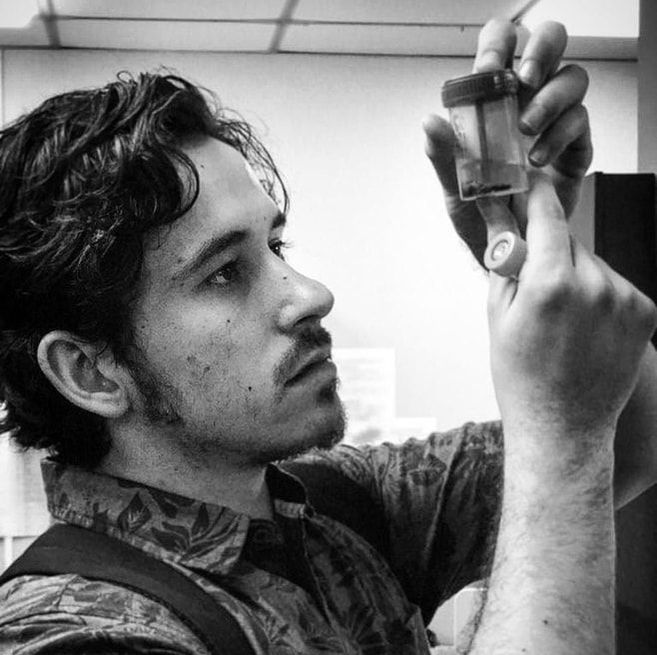Brian Leydet, MPH, PhDDr. Leydet is an vector-borne disease biologist who completed his doctoral work under the guidance of Dr. Fang Ting Liang at LSU's School of Veterinary Medicine, where he studied tick-borne diseases in understudied areas, and the pathogenic potential of Borrelia bissettii. This training complemented both his Master of Public Health degree as well as his experience as an EMT-Paramedic. His multidisciplinary training was further expanded during his postdoctoral studies under the mentorship of Dr. Timothy Sellati at both the Trudeau Institute in Saranac Lake NY and Southern Research in Birmingham AL. Brian is interested in understanding underlying factors that drive vector-borne disease enzootic cycles. He loves the outdoors and spends much of his free time fishing and snowboarding. Download his CV.
|
Karine Posbic Leydet, MS, PhDDr. Leydet is an evolutionary biologist who completed her PhD at LSU in the Department of Biological Sciences' division of Systematics, Evolution, and Ecology under the advisement of Dr. Michael Hellberg. Her doctoral work investigated the demographic history and current range expansion of an invasive coral species in the Mediterranean Sea. Her master's research conducted at GWU investigated gene flow in marbled salamanders. Karine is largely interested in understanding the processes that help shape and maintain species' diversity, abundance, and distributions especially in light of environmental changes. She completed her postdoctoral research in the Friedman Lab at Syracuse University (now at Queens University), and can be spotted in and around the lab providing expert advice. Visit her website.
|
Ben AkerPhD student (major professor: Dr. Cynthia Downs)
Ben is studying how West Nile Virus and its mosquito vectors impact occupation of early successional habitat by ruffed grouse. |
Sam Gilvarg, MSPhD student (major professor: Dr. Andrew Vander Yacht)
Sam is exploring how wildland fire can be utilized to promote the regeneration and survival of pyrophytic— or, fire adapted— plant species and ecosystems, while simultaneously mitigating the threat posed by ticks to human communities through the creation and maintenance of abiotic environmental conditions that are unsuitable to tick survival. |
You? |
Lab Alumni
Zaara Sarwar, PhD |
Lorne Farovitch, MS, PhDPhD student in Translational Biomedical Science Program (University of Rochester; major professor: Dr. Tim Dye)
Defended and graduated 2020 Lorne's multidisciplinary dissertation on ticks was composed of three collaborative projects: 1) determining novel bio-diagnostic testing, 2) evaluating geographic distribution of tick-borne diseases, and 3) determining the effective preventive strategies for Deaf populations. |
Ben Gallo, MSMaster's student (co-advised by Dr. John Farrell)
Defended and graduated 2019 Ben investigated the composition of the gut microbial communities in fishes of the Upper St. Lawrence River (namely Northern Pike (Esox lucius)) using Next Generation Sequencing technologies. |
Amanda Lemoine, MSMaster's student (co-advised by Dr. John Farrell)
Defended and graduated in 2023 Amanda examined variation in the gut microbiome of fish across trophic levels and between diet types in the near shore food web. |
Kurt GielowMaster's student (major professor: Dr. Shannon Farrell)
Kurt investigated tick and Borrelia burgdorferi prevalence associated with ground foraging bird species along a gradient of human development in central New York. |
Amanda ChristianoUndergraduate student
Graduated May 2018; BS Environmental Biology, minor: Environmental Health Amanda examined the differential gene expression observed in two morphological variants of Borrelia burgdorferi using qPCR. She is currently a research technician in Dr. M. Mahmood Hussain's lab at NYU Winthrop Hospital researching diabetes and obesity. |
Rachel LangeREU student (Syracuse University) in summer 2019
Undergraduate student Graduated May 2020; BS Biotechnology Rachel investigated the prevalence of Powassan virus in groundhogs, groundhog-associated Ixodes cookei, and Ixodes scapularis to understand the different Powassan transmission cycles in nature. |
























